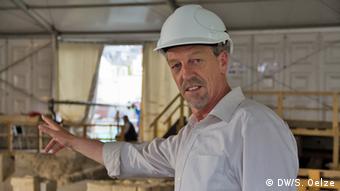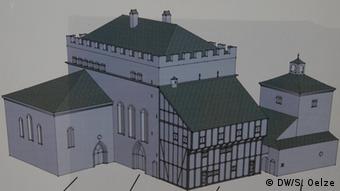Cologne's Jewish community is the oldest north of the Alps. A new museum is planned to illuminate the unknown side of the former Ancient Roman city that had become a cosmopolitan metropolis by the Middle Ages.
Gerry White points to a hole where the ruins of a medieval mikveh - a bath used in Jewish rituals - are located.
The archeologist is standing in the middle of an excavation site in the center of Cologne between the historic City Hall and the Wallraf Richartz Museum.
A tent protects the site from the elements as helmeted experts go about their work. Relics spanning 2,000 years of Cologne's history have been found in the area and the remains of walls and buildings are currently being secured.
Remains of Roman occupation
Through their research, Gerry White and his colleagues have established that a medieval Jewish quarter was founded on the ruins of an Ancient Roman development.
For a long time, researchers didn't know whether the city of Cologne had been colonized continuously from antiquity to the Middle Ages. Marcus Trier, director of the Romano-Germanic Museum in Cologne who is supervising the excavations, has found some clues.
"The ruins of the Praetorium - the palace of the Roman city fathers of the Province of Lower Germania -, relics of early medieval rule, parts of the Jewish quarter and the remains of cellars destroyed during the Second World War can all be found in the area around City Hall," he explained.
Digitally reconstructing the past
Since the 1950s and 60s, archeologists have been interested in the treasures buried in the ground around the City Hall, close to the famous Cologne Cathedral.
In 1956, the remains of a mikveh and a synagogue belonging to a medieval Jewish community in Cologne were discovered. The excavation project took around 20 years, but then a large section of the site was refilled and developed into a parking lot.
Excavation work first resumed in 2007. This time around, digital technology and scientific methods have enabled researchers to visually map the passage of time, creating detailed 3D reconstructions.
Archeologists wanted to establish how far back the roots of the Jewish community in Cologne go. At the City Hall they found parts of a synagogue, including the bimah (the platform in the synagogue from which the Torah is read), bits of kosher food, writing slates etched with phrases, and jewelry.
"A Jewish community lived in Cologne by the fourth century," Marcus Trier said. How big it was and how it functioned is not yet known. But the archeological evidence clearly shows that a large number of Jews lived in Cologne from the 10th century.
An end to a peaceful relationship
The synagogue that stood on the square near the City Hall in Cologne is the oldest north of the Alps. In the immediate vicinity, archeologists found evidence of well functioning cohabitation between Jews and Christians.



No comments:
Post a Comment